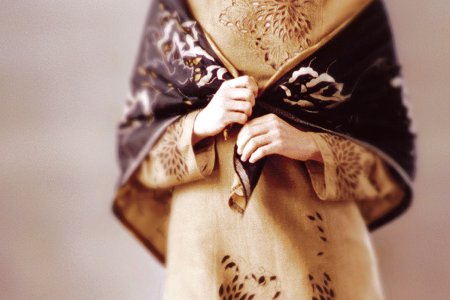
Seek in Silk
Issue 2 Nov / Dec 2003
Silk has always been regarded as the most luxurious of textile fibres. It is the silkworm 'Bombyx Mori' a species of the caterpillar that produces the finest silk fibres. Not only is it used for making exquisite fabrics but also has been used for making musical instruments, fishing-lines, bowstrings, bonds of all kinds and even rag paper which was the worlds first luxury paper.
The value of silk as a textile is due to its great strength; it's lightness and absorption of dyes. It drapes well, is lustrous, resilient, strong and resistant to tearing. Silk threads are woven into cloth or used for embroidery work. Clothes made from silk are not only beautiful and lightweight; they are also warm in cool weather and cool in hot weather.
The origin of silk production and weaving began in China, but by the 1st millennium BC they had begun trading silk cloth abroad. By the 2nd Century AD India was shipping its own raw silk and silk cloth to Persia. Persia became a centre of silk trade between East and West and silk dyeing and weaving developed as crafts in Syria, Egypt, Greece, and Rome.
Trading standards were put in place in the Muslim world in the 9th Century, therefore the silk they produced had to be of an extremely high quality. It was soon renowned as the haute couture of silk above and beyond silk from China.
Middle Eastern silk was edged with Arabic writing to show its origin and this signature was proudly worn to denote the quality of the garment. In the 15th century, painters such as Friar Angelico painted the Holy Family and the angels, in silk with Arabesque writing on its edges.
Syria, with its strategic placement on the Silk Road, developed an important silk industry and by the eighth century it was known as a centre for Luxury silks. By the 13th Century, the Islamic countries had full control of the silk trade under Ottoman rule.
Looking after Silk
Silk is a protein fibre, like hair. So as a general rule dry-clean only.
Alternatively, for those who prefer to handwash: To retain a silk’s true colour add quarter cup of white vinegar to each 2 gallons of luke warm water.
Wash with a good soap compatible with silk finishes, squeeze but never twist or wring to remove the excess water.
Wash each piece separately.
Rinse with cool water several times, strong colours may bleed, which should cease after several washes, add a few shakes of salt to the final rinse to help set the dye.
Non - suede and plain silks, dry with towel, hang in dark place and iron on low temperature on wrong side while still damp.
Sueded and sand washed silks, hot dryers are recommended to bring up finish and softness.
Keep in mind shrinkage will occur, some loose weaves may shrink by 15%.
What not to do
Never expose silk to strong direct sunlight. Silk will fade.
Never spray perfume or deodorant on silk.
Never soak silk in water for along period of time.
Bookmark this |
|
Add to DIGG |
|
Add to del.icio.us |
|
Stumble this |
|
Share on Facebook |
|
Share this |
|
Send to a Friend |
|
Link to this |
|
Printer Friendly |
|
Print in plain text |
|


Comments
0 Comments